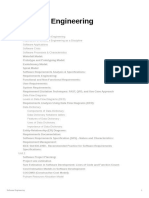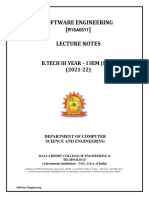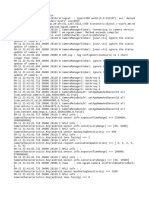0 ratings0% found this document useful (0 votes)
4 viewsSoftware Engineering Class Notes
Software engineering applies engineering principles to software design, development, maintenance, and evolution, ensuring reliability and cost-effectiveness. The Software Development Life Cycle (SDLC) includes stages such as requirements gathering, design, implementation, testing, deployment, and maintenance, with various models like Waterfall, Agile, and DevOps. Key principles include modularity, abstraction, and encapsulation, while practices like version control and code reviews enhance software quality and maintainability.
Uploaded by
salihsami79Copyright
© © All Rights Reserved
Available Formats
Download as DOCX, PDF, TXT or read online on Scribd
0 ratings0% found this document useful (0 votes)
4 viewsSoftware Engineering Class Notes
Software engineering applies engineering principles to software design, development, maintenance, and evolution, ensuring reliability and cost-effectiveness. The Software Development Life Cycle (SDLC) includes stages such as requirements gathering, design, implementation, testing, deployment, and maintenance, with various models like Waterfall, Agile, and DevOps. Key principles include modularity, abstraction, and encapsulation, while practices like version control and code reviews enhance software quality and maintainability.
Uploaded by
salihsami79Copyright
© © All Rights Reserved
Available Formats
Download as DOCX, PDF, TXT or read online on Scribd
You are on page 1/ 5
Software Engineering Class Notes
What is Software Engineering?
Software engineering is the application of engineering principles to the
design, development, 1 maintenance, and evolution of software. It's a
systematic approach to building reliable, efficient, and cost-effective
software systems. It encompasses technical aspects as well as
management and business considerations.
Software Development Life Cycle (SDLC):
A framework defining the stages involved in developing software.
Different models exist, but common stages include:
Requirements Gathering: Defining the software's purpose,
functionality, and constraints based on user needs. This often
involves user stories, use cases, and prototypes.
Design: Creating a plan for the software's architecture,
components, and interfaces. This can involve various diagrams
(UML), design patterns, and architectural styles.
Implementation (Coding): Writing the actual code based on the
design. This stage involves choosing appropriate programming
languages, tools, and coding standards.
Testing: Verifying that the software meets the requirements and is
free of defects. This includes unit testing, integration testing,
system testing, and user acceptance testing.
Deployment: Releasing the software to users or putting it into
production. This may involve setting up the environment,
migrating data, and training users.
Maintenance: Fixing bugs, adding new features, and adapting the
software to changing requirements. This can be a significant part
of the software lifecycle.
Software Development Models:
Waterfall: Linear, sequential approach. Each stage is completed
before moving to the next. Simple but inflexible.
Agile: Iterative and incremental approach. Focuses on frequent
releases and customer feedback. More flexible and adaptable to
change. Scrum and Kanban are popular Agile frameworks.
Spiral: Risk-driven approach. Combines elements of waterfall and
iterative models, with a focus on risk management.
DevOps: A set of practices that combines software development
(Dev) and IT operations (Ops). Aims to shorten the SDLC and
provide continuous delivery.
Key Principles of Software Engineering:
Modularity: Breaking down the software into smaller,
independent modules. Improves maintainability and reusability.
Abstraction: Hiding complex implementation details and
exposing only essential interfaces. Simplifies development and
reduces complexity.
Encapsulation: Bundling data and methods that operate on that
data within a unit (e.g., a class). Protects data integrity and
promotes modularity.
Information Hiding: Limiting the visibility of internal details of a
module to other modules. Enhances maintainability and reduces
dependencies.
Cohesion: The degree to which elements within a module are
related. High cohesion is desirable.
Coupling: The degree to which modules depend on each other.
Low coupling is desirable.
Software Engineering Practices:
Version Control: Tracking changes to code and allowing for
collaboration. Git is a popular version control system.
Code Reviews: Having other developers review code to catch
errors and improve quality.
Testing: Writing and executing tests to ensure software quality.
Continuous Integration/Continuous Delivery (CI/CD):
Automating the build, test, and deployment process.
Refactoring: Improving the structure and design of existing code
without changing its functionality.
Software Design Patterns:
Reusable solutions to common design problems. Examples include
Singleton, Factory, Observer, and Strategy.
Software Quality Attributes:
Functionality: The software does what it is supposed to do.
Reliability: The software performs consistently and without
failures.
Performance: The software is efficient in terms of speed and
resource usage.
Security: The software protects data from unauthorized access.
Usability: The software is easy to use and understand.
Maintainability: The software is easy to modify and fix.
Portability: The software can be run on different platforms.
Software Engineering Tools:
IDEs (Integrated Development Environments): Provide tools
for coding, debugging, and testing. Examples: Eclipse, IntelliJ
IDEA, Visual Studio.
Version Control Systems: Git, SVN.
Testing Frameworks: JUnit, pytest.
Project Management Tools: Jira, Trello.
Importance of Software Engineering:
Complex Systems: Software engineering is essential for building
complex software systems that meet user needs.
Reliability: It helps ensure that software is reliable and performs
as expected.
Maintainability: It makes software easier to maintain and evolve
over time.
Cost-Effectiveness: It helps reduce the cost of software
development and maintenance.
Further Study:
Software engineering is a vast field. Further study should include
exploring specific SDLC models, design patterns, software testing
techniques, and various software engineering tools. Practical experience
through software development projects is crucial for becoming a
proficient software engineer.
You might also like
- 011 Terapia de Regulacao Orofacial (Castillo) - FuturoFono100% (2)011 Terapia de Regulacao Orofacial (Castillo) - FuturoFono179 pages
- Overview of Software Engineering- Explain Software...No ratings yetOverview of Software Engineering- Explain Software...2 pages
- Software Engineering _20250218_150635_0000No ratings yetSoftware Engineering _20250218_150635_00008 pages
- Software Engineering an Integrated ApproachNo ratings yetSoftware Engineering an Integrated Approach21 pages
- Software Engineering Notes - 1 - 1707815619210No ratings yetSoftware Engineering Notes - 1 - 170781561921092 pages
- Unit 1 1 Software Engineering IntroductionNo ratings yetUnit 1 1 Software Engineering Introduction5 pages
- Lecture One - Software Engineering introNo ratings yetLecture One - Software Engineering intro11 pages
- Software Engineering Theory (4th Sem) .No ratings yetSoftware Engineering Theory (4th Sem) .38 pages
- It b.tech II Year II Sem Se (r18a0511) NotesNo ratings yetIt b.tech II Year II Sem Se (r18a0511) Notes66 pages
- Notes on Software Design and ArchitectureNo ratings yetNotes on Software Design and Architecture15 pages
- SOFTWARE ENGINEERING_39072811_2025_01_23_16_04No ratings yetSOFTWARE ENGINEERING_39072811_2025_01_23_16_0430 pages
- Fresher Interview Questions and Answers For Software EngineersNo ratings yetFresher Interview Questions and Answers For Software Engineers7 pages
- IT B.TECH II YEAR II SEM SE (R18A0511) NOTES (1)No ratings yetIT B.TECH II YEAR II SEM SE (R18A0511) NOTES (1)61 pages
- Mastering Software Engineering: From Basics to Expert ProficiencyFrom EverandMastering Software Engineering: From Basics to Expert ProficiencyNo ratings yet
- Bluetooth Controlled Arduino Based Robotic Arm: Srija Dasgupta Avirup Ghosh Debraj ChatterjeeNo ratings yetBluetooth Controlled Arduino Based Robotic Arm: Srija Dasgupta Avirup Ghosh Debraj Chatterjee6 pages
- FYP Thesis Template Finalized - Updated 15th June 2023No ratings yetFYP Thesis Template Finalized - Updated 15th June 202328 pages
- Patient Management Information - SystemNo ratings yetPatient Management Information - System12 pages
- Guru Gobind Singh Indraprastha UniversityNo ratings yetGuru Gobind Singh Indraprastha University51 pages
- Chapter 2: IOS Images and Licensing: Scaling NetworksNo ratings yetChapter 2: IOS Images and Licensing: Scaling Networks33 pages
- 011 Terapia de Regulacao Orofacial (Castillo) - FuturoFono011 Terapia de Regulacao Orofacial (Castillo) - FuturoFono
- Overview of Software Engineering- Explain Software...Overview of Software Engineering- Explain Software...
- Fresher Interview Questions and Answers For Software EngineersFresher Interview Questions and Answers For Software Engineers
- Mastering Software Engineering: From Basics to Expert ProficiencyFrom EverandMastering Software Engineering: From Basics to Expert Proficiency
- Bluetooth Controlled Arduino Based Robotic Arm: Srija Dasgupta Avirup Ghosh Debraj ChatterjeeBluetooth Controlled Arduino Based Robotic Arm: Srija Dasgupta Avirup Ghosh Debraj Chatterjee
- FYP Thesis Template Finalized - Updated 15th June 2023FYP Thesis Template Finalized - Updated 15th June 2023
- Chapter 2: IOS Images and Licensing: Scaling NetworksChapter 2: IOS Images and Licensing: Scaling Networks































































































